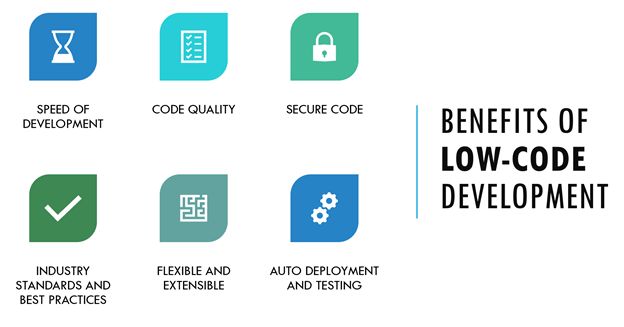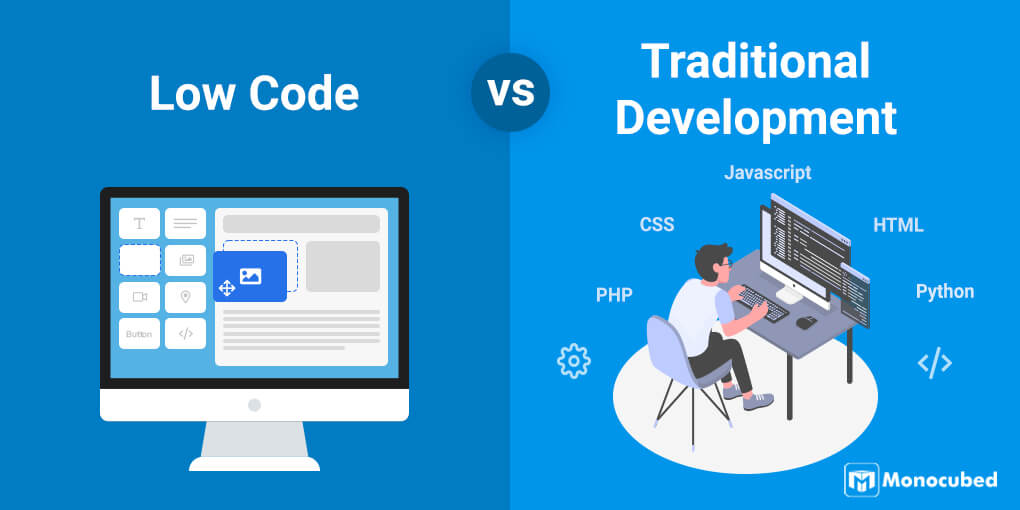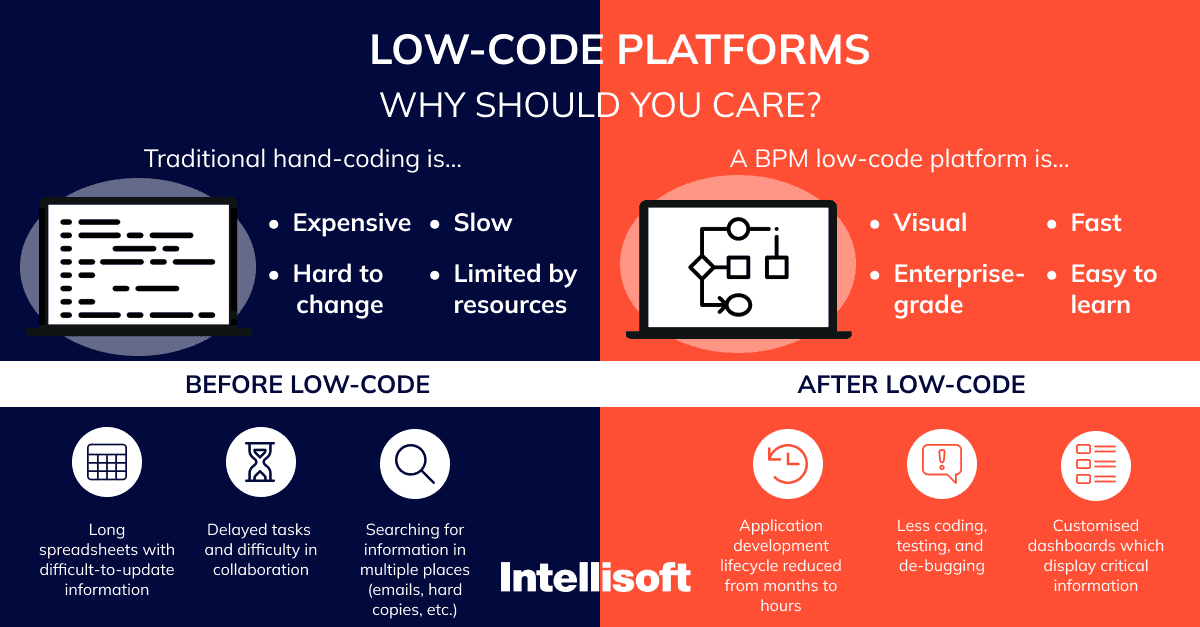Due to several factors, low-code application development is more accessible to non-developers. These are sometimes referred to as "citizens developers."
Drag-and–Drop Builders : Low-code platforms have drag-and-drop interfaces, which allow non-developers, who do not necessity of writing code, to create visual applications. This makes it much easier for those with less technical backgrounds to get involved in the process of development.
WYSIWYG: WYSIWYG editors are "What you see is what you get" editors that permit users to design workflows and interfaces in a similar manner to the finished product. It makes it much simpler to understand and use.
Simple Workflow and Logic Design
Visual Workflow Modeling: Users can create business procedures and logic for applications using visual flowcharts and models. This is a lot more simple than traditional programming methods.
Pre-built Logic components Low-code platforms contain logic components pre-built (e.g. conditional loops and statements) that can be easily configured, reducing the requirement for complex programming.
Reusable Components & Templates
Library of Templates pre-built: Numerous platforms that provide low-code also have a library of template types for common applications. This allows developers to get started quickly and easily, while non-developers can customize the templates however they see the need.
Reusable Widgets and Modules: Users can make use of modular and reusable widgets which can be created faster, reducing the time needed to create them and reducing the requirement for technical expertise.
Guided development and tutorials:
Step-by-Step guides: Platforms provide tutorials and online assistance to non-developers who are building applications.
Interactive Tutorials. Interactive, hands on tutorials allow users to learn through doing.
Integration with tools already in use
seamless integration: Low-code platform are designed to seamlessly integrate with the existing systems, tools, as well as software (e.g., ERP and CRM). This allows non-developers who don't have a prior experience in programming to design applications that can work seamlessly with their current workflows.
APIs, connectors: These tools make integration easier by allowing non-developers (or even end users) to link their applications to external services.
Collaboration Features:
Team Collaboration: Features such as real-time collaboration, as well as shared workspaces let non-developers to work with business analysts, professional developers, and other stakeholders effectively.
Access Control Based On Roles: Non-developers can have access to roles and levels of access that allow users to contribute, without compromising functionality or security.
Automated Testing & Debugging
Low-code platforms come with tools to test and debug that are built-in. They automatize this procedure, making it much easy for non-developers to make sure their apps run.
Error Highlighting - If issues occur, the platform identifies problems and provides solutions, while guiding users through troubleshooting.
Overall, the advantage of developing applications using low-code in terms of accessibility for non-developers is in its ability to make development more accessible. By offering visual-friendly tools and experiences, low code platforms enable business owners to actively participate and maintain applications. Have a look at the best Low-code Platform for application development for blog tips including app development platform, microsoft azure sql, push notifications, database in azure, developing mobile apps, develop web application, develop cross platform mobile app, developing mobile apps, mobile app development platforms, develop web app and more.

Advantages Of Low-Code Application Development In Terms Of Cost-Effectiveness
The low-code approach to app development is an affordable solution that has many benefits. It's a great option for companies looking to maximize their budgets and deliver quality apps. Here are a few of the most important benefits:
Lower Coding Requirement: Low programming platforms eliminate the need to code by hand and save developers time as well as money. This leads to lower costs of labor.
Fewer Developer Resources: Since low-code development is faster and easier, fewer developers are required. This will reduce the hiring and personnel costs.
Speedier time to market
Accelerated Cycle of Development Visual tools that are low-code and components allow for rapid application creation, which allows businesses to launch products more quickly. This can result in quicker revenue growth and better position in the marketplace.
Rapid Prototyping. By quickly creating and testing prototypes businesses can cut down on time spent developing and develop faster upon user feedback.
Low Maintenance Costs
Simpler Maintenance: Low-code platforms with their modular components and standardised components, are easier to maintain. Maintenance and support costs are reduced.
Automated Updates: Many low-code platforms can handle patches and updates automatically and ensure that applications are secure and up-to-date, without the need for lengthy manual intervention.
Efficient Resource Utilization:
Contributions from Non-Developers: Low-code platforms enable both developers and business users to participate in the process of development. This allows employees and employers to cooperate, and reduces the dependence on highly paid developers.
Improved Utilization of IT Resources: IT departments are able to concentrate on more strategic projects instead of being slammed with mundane development tasks, improving overall productivity and efficiency.
The Scalable Pricing models
Subscription-Based Prices: Many lowcode platforms have flexible, subscription-based price models that increase as users use them. This allows businesses to alter their budgets according to their growth and requirements without paying huge upfront costs.
Pay-Asss-You-Go Option: Some platforms offer pay-as-you-go options that ensure businesses only pay when they utilize resources. This is especially helpful for startups and smaller companies with small budgets.
Reduction of Third-Party Costs for Software:
Built-in Functionalities: Low code platforms come with many built-in functions and integrations, which reduce the need for third-party software and tools. The cost of subscriptions and licensing costs are also cut down.
Pre-Built integrations: These pre-built systems and services are integrated with popular services, which eliminates the requirement for custom-designed software and saves both time and money.
Improved ROI:
A faster return on investment (ROI) Through making use of the rapid development process, less expense and a quicker time to the market, businesses can achieve an increased ROI on their apps.
Enhanced Agility: Businesses can quickly adapt to market changes and customer needs to ensure they remain current and take advantage of new opportunities as they arise.
Costs of training are lower:
User-Friendly Interfaces: Low code platforms are user-friendly and have simple interfaces that reduce the time required to learn.
Accessible resources: Many low-code platforms have comprehensive tutorials, training materials, and community assistance which reduces the need for formal training.
Collaboration can be made more efficient.
Improved Collaboration Tools: Inbuilt collaboration tools facilitate better communication and coordination among team members, resulting in improved development efficiency and a reduction in project costs.
Unified Development Environment: A single integrated development environment helps streamline workflows and reduces the difficulties and expenses associated with managing multiple platforms and tools.
In the end, the value of low-code development comes from its ability to reduce development and maintenance costs and speed up time to market, optimize the utilization of resources, and offer flexible pricing models. Low-code can provide significant financial benefits for businesses. Take a look at the recommended wavemaker.com coding for website tips including rad development, app modernisation, no code platforms, lowcode no code, azure sql server, develop cross platform mobile app, application modernization, jdbc server, rapid applications, application development platforms and more.

Benefits Of Low-Code Application Development In Terms Of Customization And Constraints
The low-code approach offers an approach that is balanced and allows for significant customization and addresses limitations. These are the key advantages: Handling the limitations
Overcoming Complexity Barriers
Simple development: Low-code platforms streamline the process by providing templates and pre-built elements. This facilitates faster applications to be deployed, even complex ones.
Guided Workflows: Many platforms offer wizards or workflows that assist developers with complex processes. This reduces the risk of errors and assures consistency.
Scalability Solutions
Built-in Scalability: Low-code platforms come with a variety of features that allow for an architectural design that is scalable, allowing applications to take on a greater loads without major redevelopment.
Performance Monitoring: Integrating tools for performance monitoring as well as tuning, optimization and tuning can help applications scale efficiently.
Security and compliance
Integrated Security Features : Low code platforms are equipped with security features that are built in including encryption and access control based on role. They also conduct automated checks for compliance to identify security issues.
Regular Updates: Platforms frequently change their security protocols and compliance procedures. This makes sure that applications remain secure from new threats.
Customization:
Extensibility:
Low-code platforms tend to integrate custom-written code such as JavaScript or Python which allows developers to expand their capabilities beyond what is normal.
Developers can create customized modules or plugins to address specific business requirements.
APIs and Integration
API Support: Comprehensive support for APIs enables seamless integration with external systems and services, allowing for extensive customization and connectivity.
Low-Code Platforms: These platforms provide pre-built connectors for popular third-party service providers, making it easier to connect and modify apps.
Designing UI/UX that is flexible:
Flexible User Interfaces for Developers: Designers are able to alter and create user interfaces that meet specific specifications for branding and usability, providing a tailored user experience.
Responsive Design: The apps can be adapted to fit various screen sizes and devices.
Business Logic Customization
Visual Workflow Builds Visual tools allow for the customization of workflows as well as business rules, and also to create complex, tailored processes.
Conditional Logic & scripting: Platforms permit the use of conditional logic, and scripting that is custom-made to handle specific business rules.
Data Management
Custom Data Models Developers can choose to design custom data models specifically for particular applications, adjusting data handling to specific business requirements.
Advanced Data Processing : Integration with sophisticated tools and capabilities for data processing allow customizing how data is analysed, and used within your application.
Balanced limitations through customisation
Frameworks and Standards
Best Practices in Compliance: Low-code platforms encourage adherence to industry best practices and standards. This assists in maintaining high-quality robust, and secure applications.
Governance Frameworks. Inbuilt frameworks for governance make sure that any modifications do not compromise security, compliance or the integrity of the software.
Iterative Development:
Rapid prototyping: Being able to rapidly prototype and test their modifications developers can refine their designs based on user feedback to improve the functionality of the application.
Continuous Improvement: Low-code platforms support continuous improvement, which allows for ongoing customization and enhancement when business requirements change.
User Empowerment
Helping Citizen developers become empowered: The Low-Code interfaces that are intuitive allow non-developers to make customizations. This boosts the number of contributors able to enhance and modify applications.
Training and Support: A lot of platforms provide an extensive amount of training and support to help users make effective customizations without compromising the stability of the application, or its performance.
In general, low-code development gives a strong system for dealing with limitations, as well as a wealth of opportunities for customization. This allows companies to build and maintain apps that function and tailored to specific business needs. All while maintaining security, quality as well as scalability and standards.
